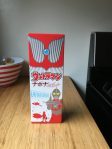S.Q. Eries's Blog, page 36
November 22, 2016
Manga Review: A Bride’s Story Vol. 8
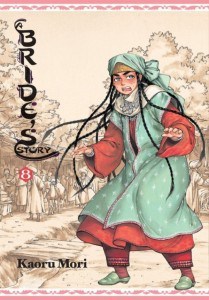 Kaoru Mori is best known for her work, Emma, an exquisite romance/slice-of-life set in Victorian England. Her latest work to be released in the United States, A Bride’s Story, is also a historical/slice-of-life but is vastly different than Emma. Set in Central Asia in a rural town near the Caspian Sea during the early 19th century, A Bride’s Story revolves around a young woman, Amir, who arrives from a distant village across the mountains to marry Karluk, a boy 8 years her junior. Volume 8 has been released, and you can read on for the review. (For reviews of other volumes, click here.)
Kaoru Mori is best known for her work, Emma, an exquisite romance/slice-of-life set in Victorian England. Her latest work to be released in the United States, A Bride’s Story, is also a historical/slice-of-life but is vastly different than Emma. Set in Central Asia in a rural town near the Caspian Sea during the early 19th century, A Bride’s Story revolves around a young woman, Amir, who arrives from a distant village across the mountains to marry Karluk, a boy 8 years her junior. Volume 8 has been released, and you can read on for the review. (For reviews of other volumes, click here.)
Back Cover Blurb
As Anis and Sherine settle into a new life built on love and friendship, tragedy and destruction have thrown the Eihons’ village into turmoil. Conflict with neighboring tribes has taken its toll, leaving Pariya’s family home in ruins. Though no one was hurt, little survived the assault, including the fabrics meant for Pariya’s dowry. Her passionate, frank personality has made things difficult for Pariya in the past, and being forced to delay marriage talks–now that she’s finally found an interested suitor–drives her to despair.
The Review
I’d thought we’d seen the last of avowed sisters Sherine and Anis after Mr. Smith moved on from their town, but Chapter 44 gives one last glimpse of their new life together. As Anis’ husband remarks, “You never know about these things until you’re in the same house,” but Mori-sensei makes clear that Sherine joining as a second wife results in a happily ever after for the whole family. Sherine brings a comic element to the idyllic household, and a frank conversation between the husband and his two wives reveals only mutual respect and devotion among the three. It’s a scenario too good to be true, but Anis has a fairytale life so this ending suits her story.
Then we move from the woman who has everything to the girl whose dowry has been destroyed. When we last saw Amir’s village, they’d just managed to repel a joint attack. Now the battle is over and the recovery effort underway. The town suffered casualties and structural damage, and Mori-sensei makes it personal by focusing on the losses of Pariya’s family. While they are physically unscathed, their house was destroyed and, with it, the embroidered fabrics for Pariya’s dowry.
The difficulty in finding a match for Pariya has been a running joke in the series. Now that she finally has an interested suitor, the wedding’s delayed until she can rebuild her dowry–from scratch. So it’s both sad and hilarious when she rants about how she’ll die unmarried. Fortunately, Pariya’s got friends to help her through the crisis. Amir’s family, which has taken Pariya’s family in, provides the despondent girl with sewing material to restart and guidance to help her over her dislike of embroidery. So against a backdrop of salvaging enemy weapons and hauling bricks for reconstruction, we have a couple chapters focused predominantly on embroidery.
Pariya’s energetic, frank personality is well established, but we know almost nothing about her groom, Umar. However, once he hears news of the attack, he gets a chance to shine. He and his father come to help rebuild, and Pariya–and all the townsfolk–see what he’s capable of. Pariya, who’d been favorably disposed toward him before, grows even more attracted, which results in an increase in awkwardness for the poor girl.
In the midst of Pariya’s efforts to remake her dowry and herself so she can marry Umar before he changes his mind, Mori-sensei also gives a glimpse of what happened to the Halgal. Characters keep hinting at the tensions encompassing the larger region, and although the Russians have yet to show up, it’s probably just a matter of time before they do.
Extras include Mori-sensei’s manga style afterword.
In Summary
From the wife who has everything, the story shifts to the girl who despairs of becoming a bride. Between the shock of losing her house and the surprise of an unexpected visit from her intended, Pariya goes through quite an emotional roller coaster. While the concept of embroidering a heap of fabric in order to get married is foreign to Westerners, readers will be able to relate to Pariya’s adolescent turmoil as she strives to become a bride her intended can be proud of.
First published at the Fandom Post.


November 18, 2016
Research Ramblings: 19th Century Eyeglasses and the Museum of Vision, Part 2
As mentioned in Part 1, the search for the specifics of mid-19th century eyewear brought me to the Museum of Vision. As to my questions, I first wanted to know where my working class heroine could purchase her first glasses and how much of a dent they would they make in her post-Civil War budget.
This was Jenny’s response:
Regarding who sold eyeglasses, this is a question that has many answers. According to Joseph Bruneni, author of “Looking Back: An Illustrated History of the American Ophthalmic Industry,” everyone in America who was concerned with eyesight was an “oculist” until the 1800s. This is when American medicine became organized (the AMA was founded in 1847) and people grew concerned about the lack of adequate medical training and licensure in the U.S. Over the next 50 years oculists then moved into two camps- ophthalmologists (trained physicians) and opticians. Amongst opticians, there were two more subcategories: “refracting opticians” and “dispensing opticians.” Refracting opticians were the newer group – they applied the newest methods to test eyesight and prescribe eyeglasses. Dispensing opticians simply had a stock of eyeglasses that the customer tried on until they found a pair that more or less worked.
Ophthalmologists, as physicians, usually opened a practice or clinic from which they could prescribe glasses but also perform surgery. Ethics barred them from advertising and it was generally considered to be a poor reflection if a practice was on the ground floor of a building. Refracting opticians did not have these constraints. They advertised freely and generally set up retail stores off the street. Dispensing opticians could have been anyone, the jewelry store and pharmacy being two popular places to shop for glasses.
The jewelry store and pharmacy! That was a surprise. I’d thought prescription glasses at the drug store was a relatively new development, and glasses are definitely not part of the modern jewelry store’s lineup.
As for the cost, Jenny emailed me this:
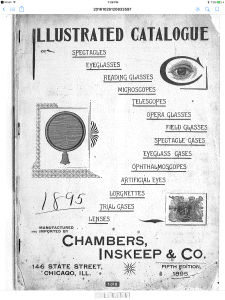
Cover of an eyewear catalog from 1895
Pretty cool! This catalog was printed 25 years after the period I’m interested in, but Jenny informed me that the styles wouldn’t have changed much.
More in my next post!


November 15, 2016
Manga Review: Oresama Teacher Vol. #21
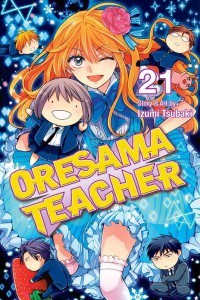 Mafuyu is a high school delinquent who wants to turn over a new leaf. So when she transfers schools, she thinks she’ll finally be able to live the life of a normal girl. There’s just one problem: her teacher Mr. Saeki is a bigger delinquent than she is!
Mafuyu is a high school delinquent who wants to turn over a new leaf. So when she transfers schools, she thinks she’ll finally be able to live the life of a normal girl. There’s just one problem: her teacher Mr. Saeki is a bigger delinquent than she is!
Oresama Teacher is a shojo manga that offers humor of the silly variety. Volume 21 has been released, and you can read on for the review. (For those who are interested, you can click here for my reviews of earlier volumes).
The Review
The cover for this volume confused me. The girl dominating the design didn’t match any of the Midorigaoka students so I assumed it was a tribute to Hayasaka’s cross-dressing past. It wasn’t until I read the Mafuyu/Takaomi text exchange at the very end of the book that I realized it’s actually someone from Mafuyu’s hometown. The featured cross-dresser is not Hayasaka, but West High bancho Sakurada!
That’s because Mafuyu abruptly returns home for winter break, a scene change I found jarring and irritating. After the anticipation built up during the Christmas party in Volume 20, the tension plummets as readers are forced once more to recall who is who in Mafuyu’s old gang life. This side arc, the tale of a cross-dressing date gone wrong, is actually kind of amusing once you remember the characters, but the timing makes it seem as if Tsubaki-sensei is stalling while she figures what to do about Hayasaka’s Christmas discovery.
So it’s two chapters later that we get his reaction. However, instead of the major shift in the Mafuyu-Hayasaka relationship that I anticipated, we get a new challenge for the Public Morals Club. All suspicions Hayasaka have about Mafuyu being Super Bun fall to the wayside when a Super Bun imposter appears before them! And this rabbit has an agenda. Not only does she creep out the student body, she actively attacks the Student Council where they are most vulnerable. This causes chaos for the council and reflects badly on the Public Morals Club. In addition to the comedy associated with a weird bunny-masked double, she also brings a new mystery for our characters to solve and raises additional questions about her first victim, President Miyabi. Perhaps the Student Council’s efforts didn’t bring down the Public Morals Club, but the fate of Midorigaoka High is by no means secured.
Extras in this volume include Characters and Story Thus Far, 4-panel comics, and a character relationship chart.
In Summary
After an abrupt detour to Mafuyu’s hometown for winter break cross-dressing mayhem with old allies and rivals, the story returns to the Christmas cliffhanger. But instead of forcing Hayasaka to confront Mafuyu about her secret identity, the plot takes an unexpected turn with a mysterious new character. So even though the state of the Hayasaka-Mafayu relationship remains the same, the Super Bun doppelganger brings fresh intrigue into the school.
First published at the Fandom Post.


November 11, 2016
Research Ramblings: 19th Century Eyeglasses and the Museum of Vision, Part 1
It’s been a while since I’ve rambled about research. Mainly because my current WIP is a myth retelling that doesn’t require the historical accuracy that Cynisca and the Olive Crown did. However, the WIP’s first draft is completed, and I’m looking ahead to my next project: a historical middle grade set in the U.S. North right after the Civil War.
This is not an era I’m well acquainted or enamored with. Ancient Greece and Japan have been my preferred settings. However, I discovered a historical figure whose life resonated with me, and because she lived in the mid-1800’s, that’s where I’m going. As such, my Goodreads list now includes a bunch of American history non-fiction.
The thing about this time and place is that the historical record is larger and much more complete than my ancient settings. That translates into more details I need to get right, and one of those details is glasses.
My main character wore glasses. A contemporary mentions it in a description of her. It’s a detail that could work as a plot point, but using it requires knowledge of the state of eyewear at the time. However, while I found pages and pages about the clothes of the era, there’s not much about glasses. Finally, in frustration, I did a Google search for “eyeglasses museum.”
And the Museum of Vision popped up.
Yes, folks, the American Academy of Ophthalmology has a museum dedicated to ophthalmologic history. In addition to online resources, it has galleries at the academy’s national headquarters in San Francisco, which is within driving distance of my home. But while it is open to the public, appointments are required. So I called the listed number, which put me in touch with museum director Jenny Benjamin.
As it turns out, I am not the first writer to call Jenny regarding eyeglasses history. Once I explained what I was after, she offered to email me the information I was looking for and spare me a two-hour trip into the city. And she did! Plus she answered a string of follow up questions and was super nice about it!
So if you’re looking for information on old-time glasses, go to museumofvision.org. If you can’t find what you’re after on the website, give them a call. I’m sure they can help you out.
As for the questions I posed to Jenny, I’ll share them and her answers in Part 2.


November 8, 2016
Manga Review: Spoof on Titan Vol. 1
 Kodansha’s Attack on Titan was a massive hit that is now a massive franchise. Several titles have spun off of the original, and joining the collection is the 4-komi comedy Spoof on Titan! Read on for the review of Volume 1!
Kodansha’s Attack on Titan was a massive hit that is now a massive franchise. Several titles have spun off of the original, and joining the collection is the 4-komi comedy Spoof on Titan! Read on for the review of Volume 1!
The Review
It’s not unusual for mangaka to include funny 4-komi or four-panel comic strips in manga volumes as extras. However, Attack on Titan is a franchise with a large enough following that it’s possible to create a title comprised entirely of 4-komi gag strips. That’s exactly what Kodansha’s done in Spoof on Titan. And like many Attack on Titan spinoffs, it is handled by an artist other than creator Hajime Isayama.
Spoof on Titan uses chibi style artwork, and artist Hounori’s versions of the characters are both adorably cute and recognizable. However, some panel illustrations do get a little cramped when they feature three or more characters, and the font for translation overlays on letters, books, etc., are too tiny to read. The volume is comprised of twenty-seven chapters, each four pages long, with a few splash pages in between.
Four chapters are a hodgepodge of gags, but the remaining chapters have a unifying theme or story arc. For instance, Eren suffers his comrades’ attempts to “help” when he gets a cavity in “Dental Health,” and “Boys, Girls, and Written Exams” explores the 104th Training Corp’s test prep methods. As you might guess, the content is geared toward fans already familiar with the characters’ personalities, which also makes the jokes incomprehensible to the uninitiated.
A warning to those who’ve only seen Season 1 of the anime: there are references to revelations that take place later in the saga. In other words, if you’re not aware of the secret Bertolt and Reiner share, a couple gags may prove spoilerific. However, if you don’t care about spoilers, you will certainly get the vast majority of jokes, which center around early established themes such as Sasha’s insatiable appetite and Jean’s crush on Mikasa.
Eren and his fellow 104th cadets dominate the volume, but some relatively obscure characters get a surprising amount of attention. Hannah and Franz, whose romance came to a tragic end in the Battle for Trost, get their own lovey dovey chapter. Mike’s nose also gets its own chapter, and “Oluo’s Demise” centers around the members of Squad Levi. And even though vertical manuevering action dominates the anime and original manga, there’s hardly any of it in Spoof. It has some cannon fire and Titans roaming around, but Hounori-sensei is more interested in the craziness our squad members inflict on each other.
Extras include bonus character sketches and translation notes.
In Summary
With so many personality quirks in the ranks of the Survey Corps, there’s a lot to make fun of, and Spoof on Titan does just that. Its gags aren’t so much about taking down Titans but the mental and sometimes physical damage that squad members deal to each other. A couple jokes may prove spoilerific, but if you are current on the manga and love the cast’s idiosyncracies, these chibi-style antics are likely to provide big laughs.
First published at The Fandom Post.


November 4, 2016
Souvenirs from Asia: Totoro Clock!
My husband and I generally don’t buy things on impulse. Especially if the price is over $100. Even if one of us is bewitched, the other will be yelling, “What are you thinking?”
However, on his last trip, my husband got blindsided by a level of cute too potent for either of us to resist. During his last morning in Japan, he arrived early in Akihabara for a final shopping trip. Animate didn’t open until 10am, but Edion, a nearby electronics store, was already open so he decided to wander around there until Animate opened. That’s where he saw this:
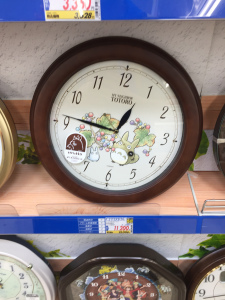
Too cute!!!
He wasn’t expecting to buy anything outside Animate, but that Totoro clock grabbed his attention and wouldn’t let go. Totoro is one of anime’s most charming representatives, after all. And the other thing was that we actually needed a clock. We hadn’t intended for it to be a ¥11,200 clock, but then again, we never thought we’d have a Totoro option.

Even the box is kawaii!
Being a good husband, he texted me a picture and asked what I thought. I too fell under Totoro’s spell, and three minutes and roughly $110 later, my husband walked out the proud owner of a Totoro clock.
Which just shows how extreme kawaii can separate an otaku couple from their money.


November 1, 2016
Manga Review: My Love Story!! Vol. 10
 Takeo Goda, the male lead for Viz Media’s My Love Story!! is quite unusual. Bishonen tend to dominate the cast of shojo manga, but Takeo’s looks are about as far from a stereotypical pretty boy as you can get. Still, he possesses tremendous appeal in this hilarious romantic comedy. Volume 10 has been released, and you can read on for the review. (For my review of other volumes, click here.)
Takeo Goda, the male lead for Viz Media’s My Love Story!! is quite unusual. Bishonen tend to dominate the cast of shojo manga, but Takeo’s looks are about as far from a stereotypical pretty boy as you can get. Still, he possesses tremendous appeal in this hilarious romantic comedy. Volume 10 has been released, and you can read on for the review. (For my review of other volumes, click here.)
Back cover blurb
Pastry chef Ichinose thinks he is best suited to be with Yamato and tells Takeo to break up with her! Takeo becomes discouraged, but he takes a stand against Ichinose even though Ichinose swears to declare his love to Yamato after he wins a pastry chef competition. Will Takeo and Yamato’s relationship survive the high-stakes baking contest?
The Review
The Ichinose arc concludes in this volume. The three members of this love triangle are so simpleminded that the ultimate outcome is pretty much a given, but it doesn’t make the chapter any less fun. Between Yamato’s and Ichinose’s brands of obliviousness and the physical humor unique to this series, readers will be plenty entertained.
Then the manga moves into territory beyond the anime. First, we have male bonding between Suna and Takeo. Interestingly, their outing is precipitated by Maki, who, at only seven months old, already exhibits a personality as big as the other members of her family.
That’s followed by one of the staples of high school manga: the school festival! The setting is actually Yamato’s school, but Takeo and his guy friends find a way to participate in her class’ Police Cafe. As usual, Takeo makes quite an impression, but unlike other situations where people get freaked out or laugh, the response from the girls’ academy is overwhelmingly positive. So much so that the longstanding “girls don’t want Takeo, they want his good-looking best friend” falls by the wayside. The chapter has a nice mix of comedy, internal turmoil, and romance, and I really hope the anime gets another season because I’d love to see this chapter animated.
The final chapter centers around another high school manga staple: the class trip! The prospect of Takeo’s and Yamato’s schools traveling to the same place is fun in of itself, but the creators throw an extra complication in the loop. Thus far, Takeo, despite his size, has treated Yamato the way an elementary school boy would treat his crush. Now, his hormones are getting revved up. He can’t seem to figure what to do about it, and I look forward to seeing the impact on the school trip and his relationship with Yamato.
Extras include story thus far and notes from the creators.
In Summary
The manga wraps up the Ichinose arc and plows on into Takeo’s love story (!!) beyond the anime. After so much attention on his relationship with Yamato, the plot switches gears to give Takeo’s buddies some air time with a Suna-Takeo sauna outing followed by a rollicking time at Yamato’s school festival with all Takeo’s friends. The series has already reached Volume 10, but its particular style of rom-com remains fresh as ever.
First published at The Fandom Post.


October 28, 2016
Souvenirs from Asia: Haikyu!! Season 3 Haul!
My husband boasts that he can now get to the Animate store in Nagoya, Osaka, Ikebukoro, and Akihabara without the help of directions. This says a lot about how he likes to spend his free time on business trips. However, in addition to the fact that he is an otaku, he like to make his rounds with these stores because each location actually carries different stock. So between four Animate stores and the Jump store in Nagoya along with the start of Haikyu!! Season Three, he returned with quite a haul of Haikyu!! goods.

Seijoh chibi charm (?) and padded pen case

Sports towels with school spirit!

Kenma on panda???
Apparently, Karasuno’s rival schools have quite following, judging from their representative goods. According to my husband, there was also a Karasuno sports towel, but the design wasn’t nearly as slick as Seijoh’s and Nekoma’s so he only wound up buying the ones for the rival teams.
Not to say that Karasuno got outclassed by its rivals in all categories. During my husband’s last trip, he brought back Hinata and Kageyama phone charms. Apparently, the collection now includes Nekoma’s setter. However, I don’t know what panda bears have to do with Tokyo, volleyball, or Nekoma High School, and Kenma just looks awkward sitting on it.

A fan for ace Bokuto and chibi themed erasers

Fits in the medicine cabinet!
While most of his purchases, like the chibi themed erasers, were “what-you-see-is-what-you-get,” we did get a bit of a surprise with one. My husband was trying to stick with practical items, ergo the simple plastic cup (something I’ve been needing for the bathroom) and towels. The eyeglass case also fell into that category. However, despite being a Jump store item, the proportions of the chibi crow on the are kind of off, enough to make it look like a counterfeit product. However, when I opened the case, I was pleasantly surprised by what is now my new favorite eyeglass wipe. And something that makes it extra special is that it’s a rare item that includes all twelve members of the Karasuno team and their support staff.
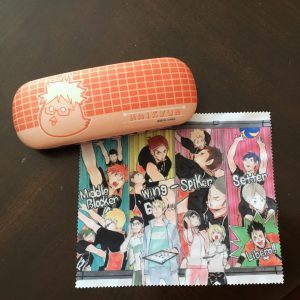
Eyeglass case and wipe
According to my husband, more Haikyu!! goods should be available as we get deeper into the anime season. However, I’ve got more than enough to keep me happy as Karasuno enters the finals against Shiratorizawa.
Go crows!


October 21, 2016
Souvenirs from Asia: Japanese snacks!
My husband and I scheduled an anime viewing at our house this month so I asked him to buy a few unusual snack foods from Japan for the party. This is what he brought back.
I am amazed he made it back with all that plus his other souvenirs AND luggage.
Since it would take too long to go through the entire stash, I’ll limit it to the highlights for this post.
First we have the nori wasabi flavored potelong. I suppose wasabi flavored snacks aren’t so unusual in the West now, but I thought the nori and wasabi high-fiving on the package was especially cute.
Next is a potato snack that definitely would not make it out West. Not sure who thought chocolate and potato would make a great combo, but it’s popular enough for my husband to find Jagachoco chocolate covered potato chips in the convenience store.
The next snack is all about the packaging. I don’t know what message the Tohato marketers wanted to convey, but to me, that Jack o’ lantern styled pepper screams, “DANGER. RUN AWAY.”
On the other end of the packaging spectrum is this. It may be just a bowl of instant udon noodles, but the kimono-clad Hello Kitty makes you feel like you’re getting something truly elegant.
Prefer a more masculine Japanese icon? How about some Ultraman raman navona? No, I have no idea what that is, but it comes from a confectionery so I assume it’s sweet.
And here’s another confectionery offering. I was surprised my husband found this one because Initial D is over a decade past its heyday. Maybe Initial D fans have a raving sweet tooth that makes this product profitable? Or perhaps there’s a reboot in the works?
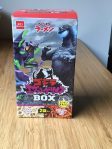 Finally, we have a snack that also a game: Godzilla vs. Evangelion! I don’t know who decided to put these two together, but at the very least the chibi character versions are really cute. My limited knowledge of kanji tells me the circle and characters on the back of the box are used to play something, but I’ve no idea what. However, our Japanese-literate friend JB is coming to the anime viewing so perhaps our party will include monsters stomping over noodle-shaped snacks.
Finally, we have a snack that also a game: Godzilla vs. Evangelion! I don’t know who decided to put these two together, but at the very least the chibi character versions are really cute. My limited knowledge of kanji tells me the circle and characters on the back of the box are used to play something, but I’ve no idea what. However, our Japanese-literate friend JB is coming to the anime viewing so perhaps our party will include monsters stomping over noodle-shaped snacks.


October 18, 2016
Manga Review: The Heiress and the Chauffeur Vol. 2
 A forbidden love between master and servant… That theme has formed the basis of many a romance, including Viz Media’s newly released historical manga, The Heiress and the Chauffeur. The second and final volume of the series has been released and you can read on for the review.
A forbidden love between master and servant… That theme has formed the basis of many a romance, including Viz Media’s newly released historical manga, The Heiress and the Chauffeur. The second and final volume of the series has been released and you can read on for the review.
Back Cover Blurb
Sayaka’s father arranges for her to marry the son of an earl! Meanwhile, Sayaka has started to develop feelings for Narutaki… But with such a huge difference in their social standings, is it possible for Sayaka and Narutaki to be together?
The Review
This is the final volume of the series, and Ishihara-sensei introduces a rival, has Sayaka realize her love for Narutaki, and brings everything to a close in five chapters. This is a lot for one installment, yet it still dragged for me. Much of it had to do with Sayaka’s continuing cluelessness about Narutaki’s feelings and Narutaki’s lack of initiative to do anything other than catch Sayaka when she inevitably falls.
The addition of marriage candidate Akihiko Tachibana doesn’t do much to intensify the situation. He starts off as a promising element to complicate Narutaki and Sayaka’s lives, but he’s so quickly and overwhelmingly won over by Sayaka that he becomes more baffling than intriguing. As Ishihara-sensei accurately admits in an author’s note, “Mr. Tachibana changed so much it was as if he had been abducted by aliens.”
Also inconsistent is the matter of Sayaka’s foot. She alternately displays the actions of a reckless tomboy and a stumbling cripple. In Chapter 5, she leaps off a bridge into a lake and lands without trouble, but in Chapter 6, she balks at jumping from a sinking rowboat to a dock. And time and again, she trips for no better reason than to be dramatically caught by the male characters.
This is a romance so it of course has a happy ending. However, it’s not till Chapter 7 that Sayaka realizes her feelings toward Narutaki are not sisterly ones. That leaves only two and a half chapters for heiress and chauffeur to contend against and defeat the forces that would tear them apart. Sayaka’s long-absent father abruptly appears to play the ultimate obstacle to their happiness only to capitulate so quickly that he, like Mr. Tachibana, appears to have been abducted by aliens.
While the final chapter doesn’t involve a wedding, the volume includes a four-page bonus story that paints a pretty clear picture of Sayaka and Narutaki’s ever after. Other extras include embedded author’s notes and afterword. I should also mention that the artwork does include a few larger, sweeping illustrators, but for the most part, panels are small and cramped, and the printing tends to be overly dark and heavy. The dialogue translation is also confusing at a couple points, and it doesn’t help that several dialogue bubbles are arranged such that you can’t tell who’s speaking.
In Summary
Ishihara-sensei concludes with a happy ending for our heiress and chauffeur, but the journey is rife with character inconsistencies. In addition, Sayaka’s inability to recognize romantic feelings (including hers) for what they are drags down the first half of the volume, and when she finally does realize she’s in love, things move unbelievably fast in the second half. Sayaka might be touted as the universally adored “Crimson Lily” of her school, but I found her to be a frustratingly dense and somewhat pretentious heroine.
First published at The Fandom Post.








